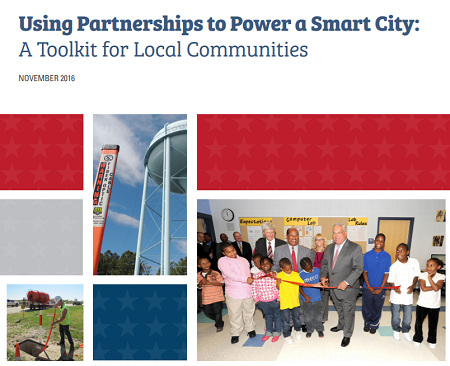Using Partnerships to Power Smart Cities: A Toolkit for Local Communities
Many cities and local communities are eyeing advances in technology as a way to increase efficiency, reduce costs, and improve quality of life for their residents – all in the face of shrinking budgets. They are seeking to become “Smart Cities” by embedding new digital technologies into municipal infrastructure. The possibilities seem endless: smart grids, intelligent transportation systems, connected street lighting, and remote healthcare to name a few.
Although smart-city infrastructure is the foundation for vibrant societies of tomorrow, today many communities do not have the required expertise to develop and sustain new large-scale infrastructure and technology projects. Many also lack the funds needed for such investments. One way to meet these challenges is to harness the resources and strengths of private-sector stakeholders – innovators, businesses, community anchor institutions, educators, and more. Private-sector partners can be an important source of capital, technical knowledge, continuing innovation and workforce development.
To assist communities, NTIA today released a toolkit for local officials and citizen groups to use as a guide for building successful public-private partnerships. Using Partnerships to Power a Smart City: A Toolkit for Local Communities identifies factors to consider when developing a partnership -- including what to look for in a partner, assessing each partner’s contribution, and guidance on how to structure the most fruitful partnership agreements. The toolkit also includes checklists to help communities as they work through the planning process.
When developing the toolkit, NTIA drew from its experience administering the $4 billion in grants funded under the Broadband Technology Opportunities Program (BTOP). The expertise it developed through overseeing BTOP led it to launch its BroadbandUSA program, which provides technical assistance to communities seeking to expand broadband deployment and adoption. NTIA’s goal is to share the knowledge we have gained working with a wide range of broadband stakeholders during the last seven years so that more communities can benefit. By equipping communities with the know-how to build long-lasting partnerships, we hope to contribute to the vibrant and sustainable smart cities of the future.
This week, BroadbandUSA staff will be in Pittsburgh to showcase the toolkit at the National League of Cities City Summit. The city of Pittsburgh recently hosted the White House Frontiers Conference, and it is participating in the White House’s Smart Cities Initiative through the MetroLab Network, collaborating with Carnegie Mellon University and the University of Pittsburgh to test new technologies. If you are attending the City Summit, stop by the BroadbandUSA booth in the Exhibit Hall to learn more about Using Partnerships to Power a Smart City.

